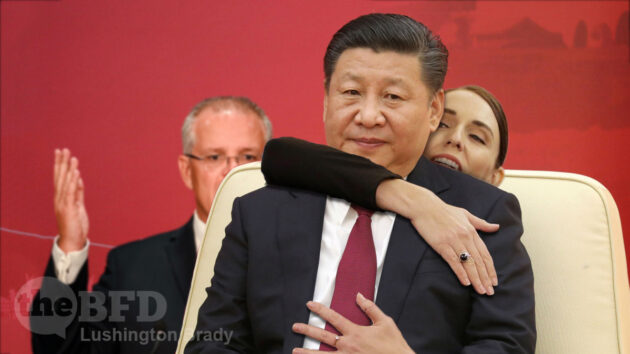New Zealand Labour governments have a noteable track record in poisoning trans-Tasman relations more thoroughly than Trevor Chappell bowling a grubber. David Lange trashed the ANZUS alliance in order to pander to the watermelon left. Jacinda Ardern, though, is making Lange look like a rank amateur. Ardern has steadily white-anted New Zealand’s oldest and strongest partnership with her constant fishwife scolding of the Australian government (not to mention the anti-Australian histrionics of her Greens partners like Golriz Ghahraman), while simultaneously cuddling closer and closer to the Chinese communist regime.

The perennial assumption of NZ Labour is that they can piss away Australia’s and America’s goodwill with impunity because, should push ever come to shove, they can run squealing to their bigger partners’ reliable protection. This is not unlike the attitude of many of America’s NATO partners, who’ve spent decades hiding from Russia behind America’s skirts while simultaneously sneering at their benefactor.
Donald Trump called NATO’s bluff when he threatened to walk away from the alliance unless European member nations started to contribute their fair share. France and Germany promptly panicked and promised to pony up.
Should the Ardern government continue down its current path so far as signing on to Xi Jinping’s notorious Belt and Road Initiative, Australian PM Scott Morrison might well have to ponder the possibility of going Trump on Ardern.
Australia and New Zealand have a proud history of shared military endeavour. Over more than a century, from the shores of Gallipoli to the sands of Iraq, Australian and New Zealand troops have fought side by side. But spine-tingling evocations of past glories neither recognise nor explain the reality of the Australia–New Zealand alliance today. With the strategic balance teetering in the Asia–Pacific, a more cold-hearted assessment is needed.
The hardest fact is that New Zealand pulls less than a third of its relative weight in the region.
New Zealanders each contribute NZ$426 to their defence; Australians spend A$1,438.
New Zealand doesn’t match Australia’s effort because it knows that Australia will shoulder the burden, at least in the local region. In exactly the same way, Australia relies on the US to shoulder the burden in the broader region. Lest there be any doubt of the pattern of reliance down the alliance chain, in recent times the US has spent around twice the share of its GDP on defence as has Australia, and Australia has spent more than twice the share as has New Zealand.
So, Australia could also be said to be guilty of not pulling its weight vis-a-vis the US. On the other hand, Australia is not just siding with the US against its greatest emerging strategic threat – China – but is seen to be leading the global push-back against Beijing’s “wolf warrior” diplomacy. Australia has America’s back – does New Zealand have ours?
New Zealand takes fewer risks of incurring Beijing’s ire than Australia, and Australia openly endorses the US role in the Indo-Pacific while New Zealand avoids the subject. It’s clear what’s happening: Australia is betting on a continued US role in the region—and its 2016 Defence White Paper says so—but New Zealand is keeping its options open[…] New Zealand is at greatest risk of becoming a Western ally with Chinese characteristics.
Which is a generous way of putting it. A less charitable assessment might be that Labour is putting New Zealand on a path to being a Chinese satellite.
Still, it’s likely that New Zealand can rely on playing both sides – for the time being, at least as Australia has more to lose than gain by jettisoning its flaky neighbour.
Treaties are static documents, but alliances are living relationships. A conscious effort is needed to stop the relationship from becoming stale and, more critically, to bolster it against buffeting from a region in strategic transition.
It’s sobering to see how far expectations have fallen for the cross-Tasman alliance. The 1986 Dibb report argued for ‘the maximum possible interoperability of equipment between the armed forces of the two countries’. Within 12 months, a memorandum of understanding was signed for the Anzac ship project. Thirty years later, defence relations remain cordial and multifaceted, but there’s nothing like the Anzac project on the horizon to generate a sense of shared purpose.
At the same time, the interoperability of the two defence forces has eroded because of diminishing equipment commonality and divergent levels of sophistication. The situation won’t be rectified any time soon: in 1986, Australia spent eight times more on defence than New Zealand; today it spends 17 times as much.
One suggestion for strengthening the alliance – or at least keeping it on life support – is for Australia and New Zealand to combine maritime surveillance efforts.
Both countries have a vital interest in having an accurate picture of the local maritime environment. By pooling physical assets and fusing data, both would gain. Faced with a similar problem, Canada and the US formed the North American Aerospace Defense Command (NORAD). Australia and New Zealand could follow this example, but with a focus on surveillance rather than air defence.
The Strategist
Even so, the question of incompatible policy objectives remains an obstacle. For instance, Australia is resolute in its policy to turn back illegal immigrant boats: Jacinda Ardern is passionately committed to signalling her “let them in” virtue. If it becomes more and more obvious that people-smugglers are opting for a circuitous route of sending boats to New Zealand, with their clients then using New Zealand residence to enter Australia by the back door, that would prove far more corrosive than Australia repatriating a few NZ-born bikies.
Please share this article so that others can discover The BFD

